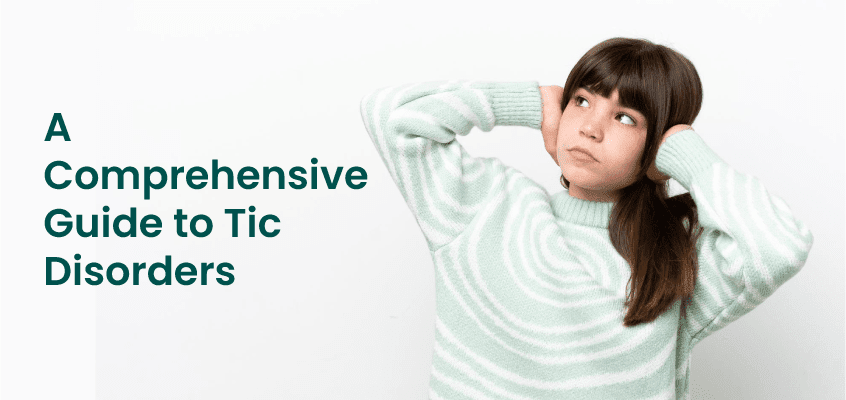Introduction
A tic is a repeated, involuntary, and rapid movement or sound that is often difficult to control and hold back. Tic disorders are usually seen in children and occasionally in adults. Most of the time, the symptoms are mild and go away on their own within 12 months. But in many cases, the condition can lead to aggressive behaviour or injury.
If you think your child or anyone you know has this disorder, read on to understand what tic disorders are and how to treat them.
What are tic disorders?
Tic disorders are either motor (related to movement), vocal (related to sound), or a mix of both. People with a tic disorder feel a sudden urge or an uncomfortable sensation, and performing specific movements or sounds helps relieve this urge. It could involve motions like nodding, wiggling fingers, and blinking, or making sounds like grunting, sniffing, and repeating a phrase.
Classification of Tic disorders is broadly into three types:
- Transient disorder: Observed in children below 18 years of age. The symptoms are mild and don’t last for more than 12 months.
- Chronic motor/vocal disorder: Observed in children below 18. The symptoms are either motor or vocal, never both, and last for more than 12 months.
- Tourette’s syndrome is a complex tic disorder involving vocal and motor symptoms.
Symptoms of tic disorders
Symptoms of tic disorders are varied. Some people are mild, but others can develop acute symptoms. The motor symptoms include:
- Blinking
- Nodding
- Grimacing
- Wrinkling nose
- Wiggling fingers
- Jerking head
- Snapping fingers
- Touching nearby people/objects.
The vocal symptoms include:
- Grunting
- Coughing
- Sniffing
- Repeating a sound
- Repeating a phrase.
If your child seems tired, stressed, angry, or excited, the symptoms of their tic disorder might occur more frequently and aggressively. Also, focusing on these symptoms can make them worse.
If your child shows one or two motor or vocal symptoms, these should go away in a few months. However, if the symptoms become more pronounced, interfere with their daily activities, or last for over 12 months, consult a paediatrician for possible solutions.
Causes of tic disorders
The exact cause of tic disorders is not yet known. However, specialists have found a few factors that might contribute to the development of this condition. The motor symptoms of tic disorders could be associated with the part of the brain that controls movements. In addition, imbalances or changes in the effects of some chemicals in the brain, such as dopamine, glutamate, and serotonin, might play a role in developing a tic disorder.
Some probable causes of this disorder include:
- Neurodevelopmental disorders like attention deficit hyperactivity disorder (A.D.H.D.) and obsessive-compulsive disorder (O.C.D.)
- Brain or head injury
- Gene mutations
- Genetics
- Surgery
- Infection
- Substance abuse
- Medical conditions include Huntington’s disease, Creutzfeldt-Jakob disease, and cerebral palsy.
Risk factors of tic disorders
Doctors have established certain risk factors for tic disorders. One or more of the factors listed below could predispose your child to this condition:
- Children around five years of age
- Being male
- Having a learning disability
- Is autistic
- Has a neurodevelopmental disorder such as O.C.D. or A.D.H.D
- Genetics.
- Please note that conditions such as autism and A.D.H.D. display symptoms similar to tic disorders. Getting a proper diagnosis done by an expert will help you get the appropriate treatment.
Diagnosis of tic disorders
To diagnose a tic disorder, doctors observe the person’s symptoms over a few months and go through their medical history. The essential criteria to diagnose tic disorders include:
- In a transient disorder, symptoms appear before 18 years of age, and one or more signs are displayed regularly for fewer than 12 months.
- In a chronic motor/vocal disorder, children develop motor or vocal symptoms before 18 years of age that last for more than 12 months.
- In Tourette’s syndrome, the person displays chronic motor and vocal symptoms.
An injury or other conditions could also cause these symptoms. To rule out that possibility, the doctor might prescribe blood and imaging tests such as a C.T. scan for your child.
Treatment of tic disorders
In most cases, tic disorders resolve on their own. In addition, if the symptoms are mild and do not disrupt daily life, treatment is not necessarily required. But if the disorder is severe or affects your child’s self-esteem, social life, and daily activities, seeking treatment might be the best option. Most treatment methods focus on your child’s symptoms and how to control them; they include therapy-based and therapeutic approaches.
Therapy-based treatments include:
- Comprehensive behavioural Intervention for tics (C.B.T.): This is a set of behavioural therapies where your child gets recognition for appropriate social behaviours.
- Habit reversal therapy: Here, your child receives training to perform voluntary movements when they feel the urge to give in to a tic. These intentional motions could work against the symptoms and work to alleviate them.
- Exposure with response prevention (ERP): This therapy trains your child to get used to the tic urges and hold them back. Since these symptoms are involuntary, ERP therapy requires much focus to succeed.
Medications for this condition include:
- Anti-psychotic drugs like risperidone; modify the effects of the chemicals in the brain that are associated with movement
- Dopamine inhibitors
- Botox injections for mild symptoms.
The doctor might prescribe a combination of therapeutic and medicinal treatments based on your child’s symptoms for the best results.
Apart from these treatment options, supporting your child will also help. If you want to make the treatment process easier for your child, you can use online mediums like United We Care, an online mental health platform that connects you with the best experts to improve your child’s life from the comfort of your home. Click here to talk to a child psychologist today!
Conclusion
Tic disorders are relatively common, and there is no reason to worry most of the time. The symptoms are generally mild and go away on their own. However, seeking medical attention is advised if the condition becomes severe or disturbing to your child.
While the exact causes of tic disorders are still a matter of research, certain therapy-based and therapeutic approaches are known to be effective. Most importantly, giving your child emotional support and letting them know they are okay can help them confront this condition head-on.










